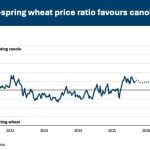Potato growers should check their seed potatoes to ensure they don’t carry late blight into next season.
Robert Spencer, a commercial horticulture specialist with Alberta Agriculture, said late blight can survive on seed potatoes even though plant foliage is frozen and dead.
Planting tubers infected with blight can result in late blight infection next year, which is easily spread to other gardens and commercial fields by wind and water-borne spores.
“The big issue is carryover from season to season,” said Spencer.
Read Also

Farmers urged to be grain-safe this fall
Working around grain bins comes with risk, from farmers falling to drowning in grain: Experts have five tips to help avoid grain-related accidents this harvest.
Late blight is termed a community disease because all types of growers can spread the disease.
“The commercial growers take every step to protect their crops. If the home gardeners don’t, it could potentially serve as a source of inoculum,” Spencer said.
In 2010, late blight was a problem in home gardens within wetter areas of central and southern Alberta. There were also a few problems in commercially grown potato fields.
Spencer said it was less of an issue this year, except in the wetter Peace River region.
“There was a lot more preventive and protective spraying going on this year. People are a lot more cautious, at least in the commercial industry.”
Recommended steps to eliminate carryover of late blight include:
• Dispose of all potato stems and foliage by burial, freezing or composting.
• Cover open compost piles with a tarp until all plant material is frozen or dead.
• Grade and sort harvested potatoes and remove any that are infected.
• Dispose of culled potatoes by feeding to livestock or by chopping and burying.
Late blight also affects tomatoes, but it cannot be spread by tomato seeds. However, it can be introduced on tomato transplants if they come from areas where late blight survives winter.
Late blight cannot survive prairie winters, so re-infection doesn’t occur by planting in the same field or an adjacent field unless there are surviving tubers in the plot. However, rotating crops is recommended whenever possible, Spencer said.
———
crops, none















